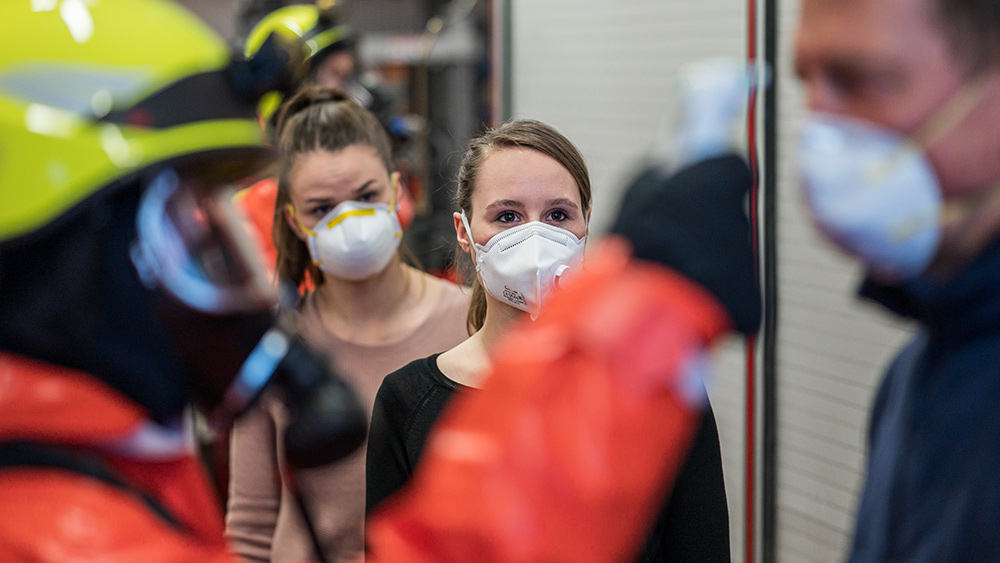“You’re not invincible” WHO warns young people as COVID-19 deaths top 13,000 worldwide
03/22/2020 / By Franz Walker

World Health Organization (WHO) officials have a warning to young people: they can still get infected with the coronavirus.
“You’re not invincible,” WHO director-general Dr. Tedros Adhanom Ghebreyesus said at a press conference on COVID-19.
“One of the things that we are learning is that although older people are the hardest-hit, younger people are not spared. Data from many countries clearly show that people under 50 make up a significant proportion of patients requiring hospitalization,” he continued.
The WHO’s warning came out just as the death toll from COVID-19 topped 10,000 Friday, then hit 13,000 Saturday, as described on a dashboard created by researchers at the Johns Hopkins Whiting School of Engineering.
Of those, Italy has the highest number of recorded deaths at 3,405?—surpassing the 3,248 reported in China. The numbers look even bleaker for the European country considering that it only has a population of 60 million, compared to the 1.437 billion of the latter.
Young people aren’t taking the outbreak seriously, but they should
Despite the increased death toll, it looks like young people aren’t taking the pandemic seriously. Early reports focused more on the increased risk that the elderly faced from the disease, which may explain this trend. In the United States, for instance, college students have continued to ignore calls for social distancing as they go their annual spring break pilgrimages to beaches in cities such as Miami.
Recent reports, however, say that young people should be concerned.
According to the Centers for Disease Control and Prevention (CDC) close to 40 percent of those hospitalized for COVID-19 fall between the ages of 20 to 54. Meanwhile, in Canada, data from the Public Health Agency of Canada show that 21 percent of cases over there are from people aged 20 to 39.
Younger people shouldn’t pass the virus off as a common cold or flu, cautioned Dr. Alon Vaisman, an infectious disease expert in Toronto.
“There are going to be individuals who, for sometimes clear reasons, sometimes unclear reasons, who are young, who will still have severe complications, related to disease,” said Dr. Vaisman in an interview Thursday night. He added that it was still more likely for a young person to experience a mild form of COVID-19.
Meanwhile, WHO’s Dr. Tedros noted that whether or not a young person falls ill to the disease themselves, they still have a role to play in stopping the spread of the disease.
“The choices you make about where you go could be the difference between life and death for someone else,” he said.
As death’s rise, so have infections
The increased death tally comes alongside a significant rise in the number of infections over the past couple of weeks. The WHO stated Friday that, based on reports from health agencies around the world, 100,000 people have become infected in just 12 days, bringing the total to around 210,000. Before this, it took three months for the number of COVID-19 patients to reach 100,000. This means that the number of new cases of COVID-19 have surged since it hit that milestone earlier this month.
Based on the WHO’s most recent data, the overall picture of the COVID-19’s spread changed markedly this month. Experts expect the number of infections to continue to rise as several countries including the U.S. continue to improve their ability to test for the coronavirus.
During the early months of the COVID-19 pandemic, its epicenter was China’s Hubei province. However, Europe now has the highest rate of new cases and more people have now died from the disease in Italy than in China.
“Italy’s death toll is more than 3,400 as the country enters its 11th day in lockdown,” NPR’s Sylvia Poggioli reported from Rome. “A decline in new cases is not expected until the end of next week.”
Besides this, Poggioli also reported that 300 volunteer doctors are being sent to the Lombardy region to provide relief to overworked medical workers there. The Lombardy region is the epicenter of the outbreak in Italy.
In a situation report published Friday morning, the WHO warned that the European region was now poised to supplant the Western Pacific region as the region hardest hit by the pandemic. The latter has 92,333 reported cases, while the former is quickly catching up with 87,108 cases.
The WHO also released a graphic showing the changing source of new COVID-19 cases by region around the world. The graphic highlighted spikes in cases in Europe and the Americas since late February.
The figures from the WHO reflect their most recent data as of late Thursday. Their tally, however, is lower than the 244,000 reported by the Johns Hopkins University dashboard, as the latter reports coronavirus numbers in near real-time.
Coronavirus has overwhelmed health systems
One reason people, let alone those who are young, shouldn’t take the coronavirus for granted is how easily the outbreak has overwhelmed health systems around the world.
“Take one look at what’s happening in some health systems around the world. Look at the intensive care units; completely overwhelmed. Doctors and nurses utterly exhausted,” stated Mike Ryan, executive director of the WHO’s emergencies program. “This is not normal. This isn’t just a bad flu season.”
During a WHO press briefing, Ryan stated that there was a shortage of protective equipment for the estimated 26 million health-care workers that would be needed to take care of COVID-19 patients.
“These are health systems that are collapsing under the pressure of too many cases,” continued Ryan, who then added that the supply chain for personal protective gear like masks, gloves and gowns is “under huge pressure.”
Meanwhile, Jonas Schmidt-Chanasit, a virologist at Germany’s Bernhard Nocht Institute for Tropical Medicine, stated that Italy’s high death rate was an example of a public health system that has been overwhelmed. “That’s what happens when the health system collapses,” he stated.
In response to this, countries throughout Europe have implemented social distancing policies to try to slow the spread of the virus and keep the number of patients within the capacity of their health systems. The governments of especially hard-hit countries such as Italy, Spain and others have even restricted travel within the country.
Several and states in the U.S. are also following suit. On Monday, San Francisco Bay Area officials ordered some 7 million residents to “shelter in place,” telling them not to leave their homes except under “limited circumstances.” The state of New York followed suit on Friday, putting stringent new restrictions on individuals while requiring nonessential businesses to keep 100 percent of their workforce at home.
When he announced the new rules, Gov. Andrew Cuomo called for hospitals in the state to increase their capacity to treat an influx of COVID-19 patients. Earlier this week, Cuomo projected that the state would need up to 110,000 hospital beds to deal with the disease, more than double the state’s current capacity.
“Right now, in New York specifically, the rate of the curve suggests that in 45 days we could have up to an input of people who need 110,000 beds that compares to our current capacity of 53,000 beds, 37,000 ICU units, ventilators, which compares to a capacity currently of 3,000 ventilators,” the governor said Wednesday. “That’s our main issue.”
Sources include:
Tagged Under: coronavirus, covid-19, Europe, Flu, government, infections, Italy, New York, outbreak, pandemic, priority, San Francisco, spring break, superbugs, US, virus, WHO

















